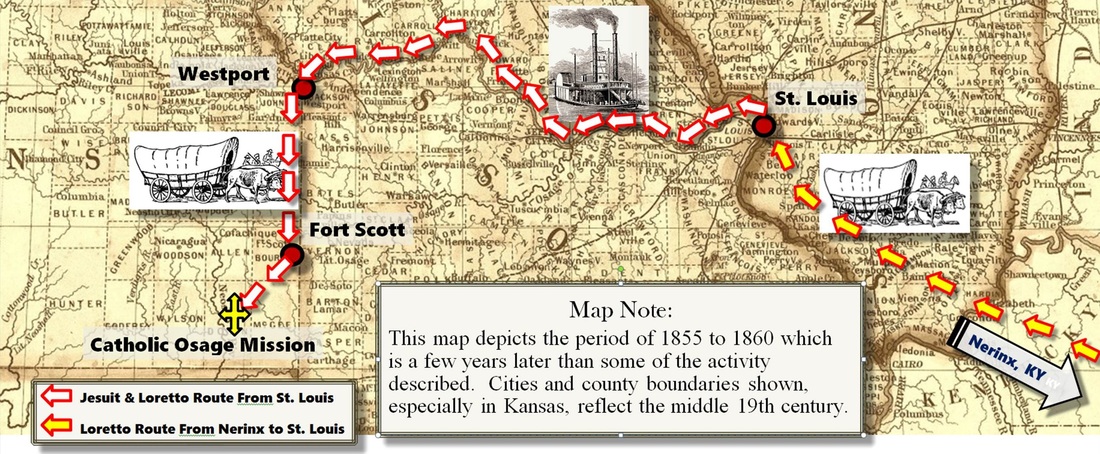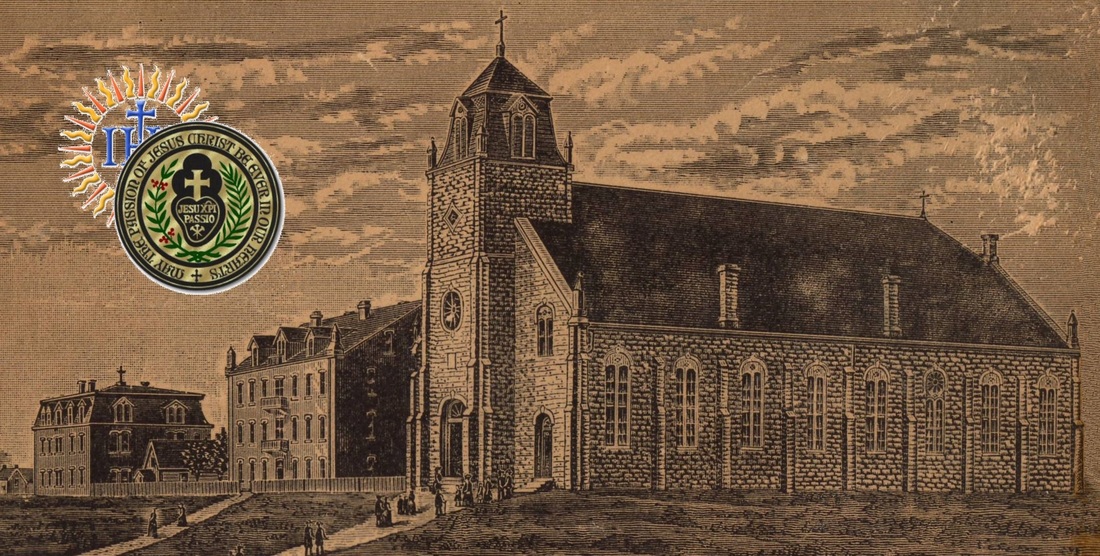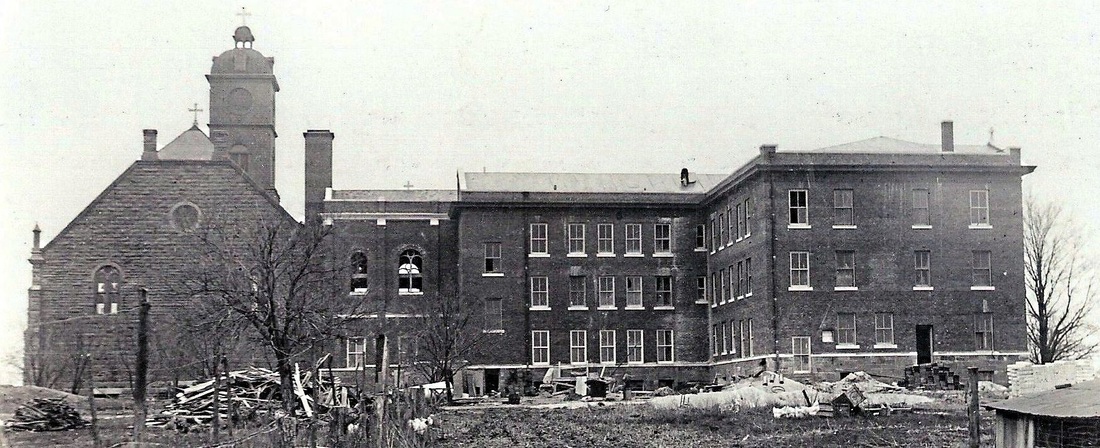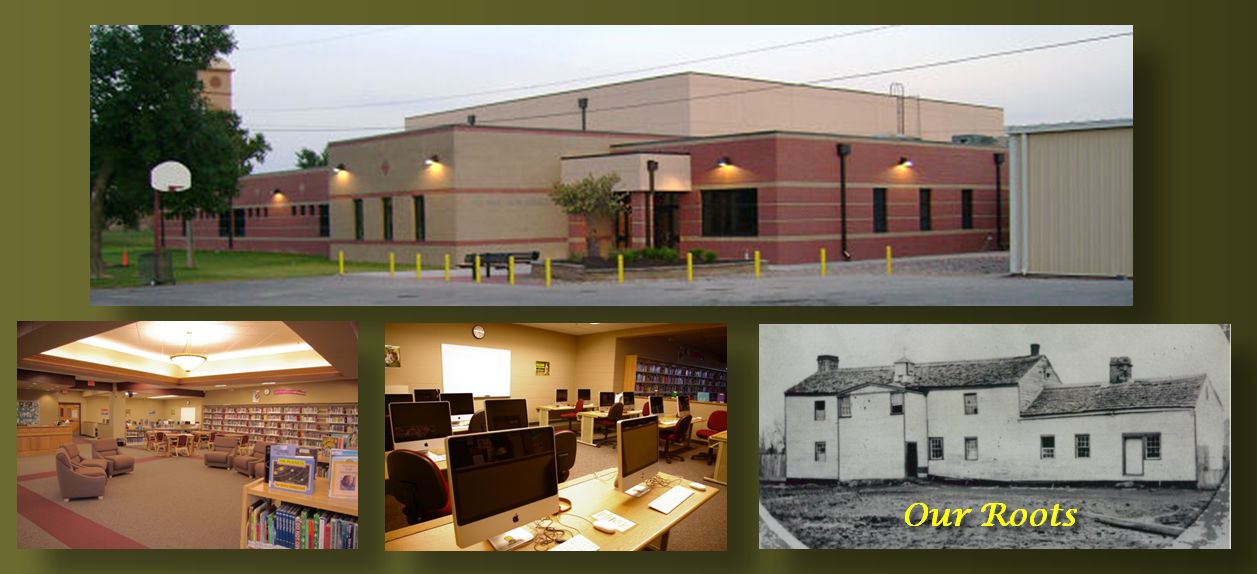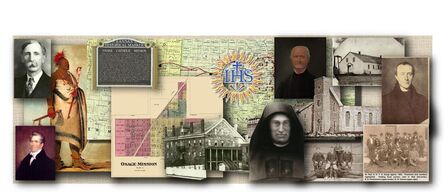- Home
- St. Francis , St. Paul
- St. Ambrose, Erie
- Education
- Organizations
-
Church Life
- Sacraments
- Sacristan Team
- Eucharistic Adoration
-
Stations of the Cross at St. Francis
>
- I - Jesus is Condemned to Death
- II - Jesus Carries His Cross
- III - Jesus Falls The First Time
- IV — Jesus Meets His Mother
- V — Simon of Cyrene Helps Jesus To Carry His Cross
- VI — Veronica Wipes the Face of Jesus
- VII — Jesus Falls The Second Time
- VIII — Jesus Meets The Women Of Jerusalem
- IX — Jesus Falls The Third Time
- X — Jesus Is Stripped Of His Garments
- XI — Jesus Is Nailed To The Cross
- XII — Jesus Dies On The Cross
- XIII — Jesus Is Taken Down From The Cross
- XIV — The Body Of Jesus Is Laid In The Tomb
- News
- Links
The approximate location of the old mission church relative to the St. Francis Rectory[1].
A Cradle of Catholicism.
"Osage Mission was a great distributing center of civilization in the state because of the nature of its organization, the genius of its missionaries, the accessibility of its location, its long duration, and its numerous outposts flung across southern Kansas."
From the introduction to Beacon on the Plains, Sister Mary Paul Fitzgerald, PhD, 1939[2].
"Osage Mission was a great distributing center of civilization in the state because of the nature of its organization, the genius of its missionaries, the accessibility of its location, its long duration, and its numerous outposts flung across southern Kansas."
From the introduction to Beacon on the Plains, Sister Mary Paul Fitzgerald, PhD, 1939[2].
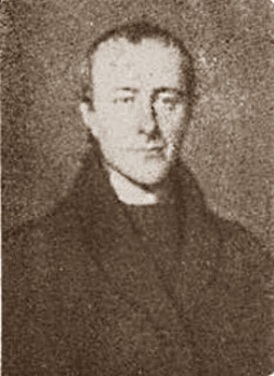 Father John Schoenmakers, S.J.
Father John Schoenmakers, S.J.
Autumn of 1846 – A Site Survey.
During the autumn of 1846 a thirty-nine year old Jesuit priest made a riverboat and wagon excursion from St. Louis to a remote location that had been chosen for an Osage Indian mission. The mission was owned by the United States government which had contracted with the Jesuits to run the facility and provide staff to teach the Osage children.
Father John Schoenmakers had been selected to run the mission. He was a native of Holland and had attended the Charles De Neff College in Belgium. The De Neff School specialized in training young men for the foreign missions and Fr. Schoenmakers was preceded by legendary Jesuit missionaries Fathers Pierre-John de Smet and Charles Van Quickenborne. He became a secular priest in Belgium in April of 1833 and departed for America on Christmas day of that year. Upon landing in the United States he traveled to Georgetown, Maryland, where he offered himself to the superior of the Georgetown Jesuit Novitiate. His education at De Neff probably made him an attractive candidate. He became a member of the Jesuit Order in January of 1834. The next ten years or so seem to be fairly routine service to the church at St. Louis University. And then a series of political events led him to be called to the service as a Kansas missionary.
Before leaving St. Louis he had been briefed on what to expect when he reached the mission site. The purpose of his trip was to check progress of mission buildings being erected by government contractors and ascertain what equipment and supplies would be needed to start and sustain the mission. He also wanted to introduce himself to the Osages who had petitioned for Jesuit missionaries for several years.
What he found was probably disturbing. The site was located thirty miles west of the Missouri border; and was in the region known as the Great American Desert. The mission was located on a low hill surrounded on the west and south by the Neosho River and by Flat Rock Creek on the east. The buildings were not completed and the contractors were uncomfortable with the remote location. They were among the very few whites in the region and they wanted to get back to civilization. Materials were scarce and they were rushing to complete the job. The corners they were cutting became evident when their buildings were occupied several months later.
Father’s meetings with the Osages were a mixed blessing. He was very warmly welcomed by the chiefs and their people. But it was then that he fully comprehended the term “savage” used to describe his new flock. His briefings in St. Louis did not prepare him for what he observed. Nonetheless, he returned to St. Louis and began assembling his missionary team and supplies.
During the autumn of 1846 a thirty-nine year old Jesuit priest made a riverboat and wagon excursion from St. Louis to a remote location that had been chosen for an Osage Indian mission. The mission was owned by the United States government which had contracted with the Jesuits to run the facility and provide staff to teach the Osage children.
Father John Schoenmakers had been selected to run the mission. He was a native of Holland and had attended the Charles De Neff College in Belgium. The De Neff School specialized in training young men for the foreign missions and Fr. Schoenmakers was preceded by legendary Jesuit missionaries Fathers Pierre-John de Smet and Charles Van Quickenborne. He became a secular priest in Belgium in April of 1833 and departed for America on Christmas day of that year. Upon landing in the United States he traveled to Georgetown, Maryland, where he offered himself to the superior of the Georgetown Jesuit Novitiate. His education at De Neff probably made him an attractive candidate. He became a member of the Jesuit Order in January of 1834. The next ten years or so seem to be fairly routine service to the church at St. Louis University. And then a series of political events led him to be called to the service as a Kansas missionary.
Before leaving St. Louis he had been briefed on what to expect when he reached the mission site. The purpose of his trip was to check progress of mission buildings being erected by government contractors and ascertain what equipment and supplies would be needed to start and sustain the mission. He also wanted to introduce himself to the Osages who had petitioned for Jesuit missionaries for several years.
What he found was probably disturbing. The site was located thirty miles west of the Missouri border; and was in the region known as the Great American Desert. The mission was located on a low hill surrounded on the west and south by the Neosho River and by Flat Rock Creek on the east. The buildings were not completed and the contractors were uncomfortable with the remote location. They were among the very few whites in the region and they wanted to get back to civilization. Materials were scarce and they were rushing to complete the job. The corners they were cutting became evident when their buildings were occupied several months later.
Father’s meetings with the Osages were a mixed blessing. He was very warmly welcomed by the chiefs and their people. But it was then that he fully comprehended the term “savage” used to describe his new flock. His briefings in St. Louis did not prepare him for what he observed. Nonetheless, he returned to St. Louis and began assembling his missionary team and supplies.
April, 1847—Father Schoenmakers Returns to Kansas.
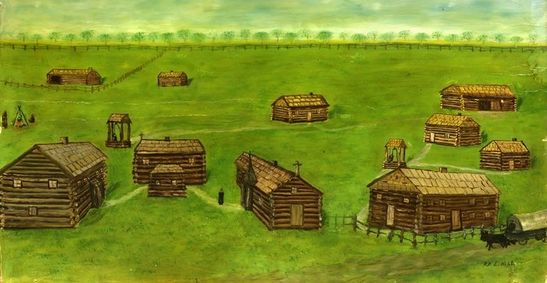 A segment of a painting done in 1930 from the memory of Charles Beechwood. It depicts the Catholic Mission as it appeared when he became its first white pupil in 1865.
A segment of a painting done in 1930 from the memory of Charles Beechwood. It depicts the Catholic Mission as it appeared when he became its first white pupil in 1865.
On April 28, 1847, several ox-drawn carts lumbered into the grounds of the newly constructed mission-yard. Five weary men climbed down from the carts and were quickly surrounded by an enthusiastic group of Osage who had come to greet the Tapuska-Watanka (priest lords). The missionaries included Father Schoenmakers and his young assistant Father John Bax; and three coadjutor brothers: John Sheehan, John De Bruyn and Thomas Coglan (Brother Thomas O’Donnell joined them in 1848). All five of the men had already immigrated to a new land when they came to America. But the Mission site might have seemed alien. Father Bax’s impression of their arrival was embodied in a letter to Father Pierre Jean De Smet:
“It would be impossible to paint for you the enthusiasm with which we were received … At first sight of these savages … I could not suppress the pain I felt … The adults had only a slight covering over the middle of the body; the little children, even as old as six or seven years, were wholly destitute of clothing. Half serious, half jesting, I thought that a truly savage portion of the Lord’s vineyard had been given to me to cultivate.”
On May 10, 1847, the Osage Manual Labor School for Boys opened with its first three students.
“It would be impossible to paint for you the enthusiasm with which we were received … At first sight of these savages … I could not suppress the pain I felt … The adults had only a slight covering over the middle of the body; the little children, even as old as six or seven years, were wholly destitute of clothing. Half serious, half jesting, I thought that a truly savage portion of the Lord’s vineyard had been given to me to cultivate.”
On May 10, 1847, the Osage Manual Labor School for Boys opened with its first three students.
Now Father Schoenmakers set about the very difficult task of finding a group of religious women to run his girl’s school. He traveled to St. Louis and talked to several orders of nuns. All of them declined. The rigors and dangers of the isolated prairie assignment were too daunting. While visiting the Loretto Mother House in Nerinx, Kentucky, he enlisted four women to come to Kansas—Mother Concordia Henning, and Sisters Bridget Hayden, Mary Petronilla Van Prater and Vincentia McCool.
The four sisters arrived at the mission on October 10, 1847 and opened the Osage Manual Labor School for Girls the same day. More boarding students came and by the end of the year the schools were reaching capacity.
The four sisters arrived at the mission on October 10, 1847 and opened the Osage Manual Labor School for Girls the same day. More boarding students came and by the end of the year the schools were reaching capacity.
Good Times and Bad Times.
At this point the Mission was functioning precariously. The nine Jesuit and Loretto missionaries were among the very few white people in the region; and all but one of them were immigrants to a new homeland. Kansas was not yet a territory and statehood was 14 years in the future. The only semblance of law or authority was at Fort Scott—nearly 40 miles away. Father Schoenmakers would become the Osages point of authority.
The Mission both flourished and struggled during its 23 years. Osage parents and students were zealous but funding was always lacking. The government built structures were of very poor construction causing constant concern. Epidemics ravaged the Osage people; and in the summer of 1852 Father Bax became ill and died in the Fort Scott infirmary on August 5th. During the Civil War the mission sat near the north-south dividing line with Fort Scott 35 miles north and Confederate guerrilla leader, John Mathews, 25 miles south. Father Schoenmakers found himself in the dangerous position of trying to maintain neutrality while managing a facility in such a vulnerable location. This dangerous situation resulted in several close calls for the mission including a period when Father Schoenmakers was driven into exile for several months. By the end of the war the Osage’s future was cast in stone. A series of treaty negotiations led to their removal to their present reserve in Osage County, Oklahoma.
At this point the Mission was functioning precariously. The nine Jesuit and Loretto missionaries were among the very few white people in the region; and all but one of them were immigrants to a new homeland. Kansas was not yet a territory and statehood was 14 years in the future. The only semblance of law or authority was at Fort Scott—nearly 40 miles away. Father Schoenmakers would become the Osages point of authority.
The Mission both flourished and struggled during its 23 years. Osage parents and students were zealous but funding was always lacking. The government built structures were of very poor construction causing constant concern. Epidemics ravaged the Osage people; and in the summer of 1852 Father Bax became ill and died in the Fort Scott infirmary on August 5th. During the Civil War the mission sat near the north-south dividing line with Fort Scott 35 miles north and Confederate guerrilla leader, John Mathews, 25 miles south. Father Schoenmakers found himself in the dangerous position of trying to maintain neutrality while managing a facility in such a vulnerable location. This dangerous situation resulted in several close calls for the mission including a period when Father Schoenmakers was driven into exile for several months. By the end of the war the Osage’s future was cast in stone. A series of treaty negotiations led to their removal to their present reserve in Osage County, Oklahoma.
Spreading the Faith.
When founded the Osage Catholic Mission served in two roles:
When founded the Osage Catholic Mission served in two roles:
- Educate the Osage children and help guide the adult tribal members toward civilization. As noted, that was done under contract with the government. While education of the children went well, civilization of the adults met with mixed success.
- What is less understood is the mission also served as the Jesuit's center of missionary operations south of the Santa Fe Trail. In this endeavor, the Jesuits were very successful and the service of some of the missionaries is legendary
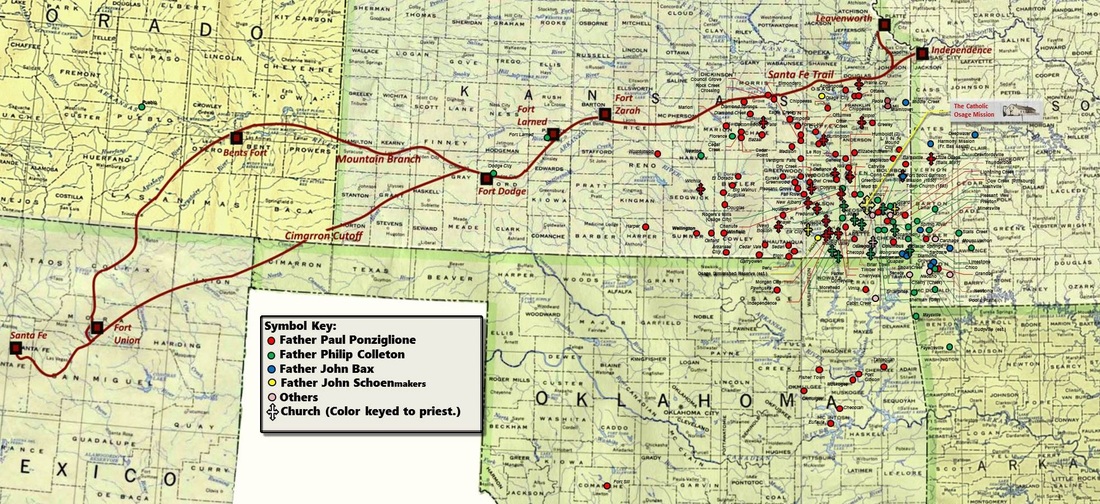
The Jesuit missionary work from Osage Mission covered a broad region that was generally bounded by the Santa Fe Trail (north) and southern Oklahoma to the south. Missions were recorded as far east as Mt. Vernon, Missouri and as far west as Pueblo Colorado. This map shows 154 mission stations. These do not count three stations served by Father Ponziglione during an assignment in Wyoming. There are very likely more that will be added with further research. As the color-code shows, many of the stations were established by Fathers Paul Ponziglione and Philip Colleton.
Trail Riders.
Missionaries like Fathers Ponziglione and Colleton were probably fueled by a certain amount of wanderlust. But it took a special kind of man to spend days in the saddle, return home and then leave again to serve Catholics in remote settlements. It was difficult, dirty and dangerous work. If a serious problem occurred, the lone rider had to solve it himself. Not doing so could have been fatal.
During the 1870's dusty trails could, at times, be replaced by the iron trails. Introduction of the railroads allowed the priests to occasionally ride in the comfort of a passenger car. But the fledgling railroads presented their own dangers. Father Colleton was involved in two construction train accidents—One near Larned, KS and one in Arkansas. It seems like cruel irony that he lost his life to injuries received on a lowly railroad handcar.
Missionaries like Fathers Ponziglione and Colleton were probably fueled by a certain amount of wanderlust. But it took a special kind of man to spend days in the saddle, return home and then leave again to serve Catholics in remote settlements. It was difficult, dirty and dangerous work. If a serious problem occurred, the lone rider had to solve it himself. Not doing so could have been fatal.
During the 1870's dusty trails could, at times, be replaced by the iron trails. Introduction of the railroads allowed the priests to occasionally ride in the comfort of a passenger car. But the fledgling railroads presented their own dangers. Father Colleton was involved in two construction train accidents—One near Larned, KS and one in Arkansas. It seems like cruel irony that he lost his life to injuries received on a lowly railroad handcar.
 It took thirteen years to build the existing church. Father Schoenmakers did not want to subject the settlers to a large debt. The church was dedicated on May 11, 1884. Father Schoenmakers died in July of 1883.
It took thirteen years to build the existing church. Father Schoenmakers did not want to subject the settlers to a large debt. The church was dedicated on May 11, 1884. Father Schoenmakers died in July of 1883.
Shifting Gears – Birth of a Very Unique Community.
By 1870 the missionaries had “shifted gears.” The Osage were gone, there were scores of settlers flooding onto the new Kansas frontier and the mission was on the doorstep of the westward expansion. The Mission was in an interesting position for another reason. Entrepreneurs wanting to start new settlements knew they needed funding for essential schools and churches. Schools and churches already existed at the Mission site as well as the early stages of commerce. Moreover, Father Schoenmakers received more than a section of land from the Osage as part of the treaty agreements. In 1868 the priest gathered a group of Fort Scott businessmen; gave them a section of land and started the Osage Mission Town Company. The town grew rapidly and much of the money from real estate sales was directed to schools.
In addition to parish schools, the Jesuits and Lorettos built two boarding colleges: St. Francis Institute for men and St. Ann’s academy for women. With the education system started, Father Schoenmakers stepped back from his town company and focused on his duties as pastor and school manager. While the boarding schools had a relatively short life, the education system started by the Jesuits in 1847 has endured. Osage Mission/St. Paul schools have not missed a term in 173 years (as of April 2020).
It was also during this period that Father Schoenmakers decided the existing log church would be inadequate for the growing population. In 1871 work was started on our existing stone church. However, funding issues delayed completion and dedication until 1884. Father Schoenmakers did not live to see it to completion.
 The Bijou Club was a group of St. Ann's students who performed concerts for the community.
The Bijou Club was a group of St. Ann's students who performed concerts for the community.
Transitions.
When W.W. Graves[3] entered St. Francis Institute in the fall of 1889 the school’s days were numbered. The Jesuits were dealing with the same issues facing many of today’s school administrators—money, resources and consolidation. There were two Jesuit boy’s schools in Kansas, one in Osage Mission and St. Mary’s School northeast of Osage Mission. Jesuit scholastics were stretched thin. St. Francis Institution held a debt of $27,000 and recurring droughts had reduced the value of the fifteen hundred acre farm. In 1891 the decision was made to discontinue operations at St. Francis Institute.
In contrast, by the start of the fall semester of 1895 St. Ann’s Academy was flourishing. The school and its students had become a part of the community and the community responded with support and affection. In the words of Sister Fitzgerald in “Beacon on the Plains:
"The schools were something of a mecca in the social life of the people. Musicales, art exhibitions, and commencement exercises drew larger crowds than the halls could accommodate in the days when entertainment was an art and not a commercial enterprise.”
On June 26, 1895, the Academy’s Bijou Club strings group presented its final Osage Mission Concert. On July 1, 1895, the name of Osage Mission was formally changed to St. Paul. On September 3 of 1895, a fire caused by a defective flue destroyed the St. Ann’s Academy Complex.
Within the brief compass of six years, 1890 to 1896, much that was historic in southern Kansas had passed away— but even today scholars and historians continue to study the Mission and its effect on the settlement of the region. Much more happened after 1895!
When W.W. Graves[3] entered St. Francis Institute in the fall of 1889 the school’s days were numbered. The Jesuits were dealing with the same issues facing many of today’s school administrators—money, resources and consolidation. There were two Jesuit boy’s schools in Kansas, one in Osage Mission and St. Mary’s School northeast of Osage Mission. Jesuit scholastics were stretched thin. St. Francis Institution held a debt of $27,000 and recurring droughts had reduced the value of the fifteen hundred acre farm. In 1891 the decision was made to discontinue operations at St. Francis Institute.
In contrast, by the start of the fall semester of 1895 St. Ann’s Academy was flourishing. The school and its students had become a part of the community and the community responded with support and affection. In the words of Sister Fitzgerald in “Beacon on the Plains:
"The schools were something of a mecca in the social life of the people. Musicales, art exhibitions, and commencement exercises drew larger crowds than the halls could accommodate in the days when entertainment was an art and not a commercial enterprise.”
On June 26, 1895, the Academy’s Bijou Club strings group presented its final Osage Mission Concert. On July 1, 1895, the name of Osage Mission was formally changed to St. Paul. On September 3 of 1895, a fire caused by a defective flue destroyed the St. Ann’s Academy Complex.
Within the brief compass of six years, 1890 to 1896, much that was historic in southern Kansas had passed away— but even today scholars and historians continue to study the Mission and its effect on the settlement of the region. Much more happened after 1895!
The Passionist Era Begins Amidst Promise, Doubt and Turmoil.
After the Jesuit departure St. Francis Catholic Church was served by two secular priests under the guidance of Bishop Fink of Leavenworth. In April of 1893, a Passionist priest, Rev. Raymond O’Keefe C.P., traveled from St. Louis to St. Paul to give a retreat. At that time the Passionist Order was seeking a location farther west and Father O’Keefe was impressed by the location, the obvious devotion of the local congregation and the historical holiness of Osage Mission. On his return to St. Louis he began correspondence with the superiors of his order. His enthusiasm was rewarded.
The November 23, 1893 Osage Mission Journal reported that “Rev. John Baptiste C. P., provincial of the Passionist Fathers, visited Osage Mission officially in regard to the movement to establish a Passionist Monastery here.” A subsequent article in the February 1, 1894 Journal noted “Raymond Newton and Miss Maude Friedman were married at the Catholic Church January 30. This was the last marriage performed in Osage Mission by Rev. Bononcini before he turned parish affairs over to the Passionists.” A February 15 story announced the arrival of Rev. Raymond O’Keefe C.P. and Rev. Fr. Sebastian C.P. who would make their home here. After this, Journal records include several articles regarding the first marriages, funerals and baptisms performed by the new Passionist priests. Ceremonies for the formal possession of the Monastery at Osage Mission were held on Sunday, September 9, 1894. An accompanying article described the ordination of seven Passionist deacons on the same date. Osage Mission was proud and relieved to have another strong, active, religious presence in their town.
But the relief was dampened by the St. Ann’s fire in September of 1895. The fire was a devastating blow to the Sisters of Loretto. With only $16,000 of fire insurance they could not afford to rebuild the academy. Despite pleas from the citizens and the Passionists the Lorettos left in August of 1896. The community followed with petitions and offers to help pay for a new school. Adding to the confusion was a division in the diocese and (now) St. Paul fell under the care of Most Reverend J. J. Hennessy, the Bishop of Wichita. Perhaps turmoil complicated communications but the decision regarding the Loretto departure was final. The Sisters of Loretto departed and the Ursuline Sisters served St. Paul for about two years.
The November 23, 1893 Osage Mission Journal reported that “Rev. John Baptiste C. P., provincial of the Passionist Fathers, visited Osage Mission officially in regard to the movement to establish a Passionist Monastery here.” A subsequent article in the February 1, 1894 Journal noted “Raymond Newton and Miss Maude Friedman were married at the Catholic Church January 30. This was the last marriage performed in Osage Mission by Rev. Bononcini before he turned parish affairs over to the Passionists.” A February 15 story announced the arrival of Rev. Raymond O’Keefe C.P. and Rev. Fr. Sebastian C.P. who would make their home here. After this, Journal records include several articles regarding the first marriages, funerals and baptisms performed by the new Passionist priests. Ceremonies for the formal possession of the Monastery at Osage Mission were held on Sunday, September 9, 1894. An accompanying article described the ordination of seven Passionist deacons on the same date. Osage Mission was proud and relieved to have another strong, active, religious presence in their town.
But the relief was dampened by the St. Ann’s fire in September of 1895. The fire was a devastating blow to the Sisters of Loretto. With only $16,000 of fire insurance they could not afford to rebuild the academy. Despite pleas from the citizens and the Passionists the Lorettos left in August of 1896. The community followed with petitions and offers to help pay for a new school. Adding to the confusion was a division in the diocese and (now) St. Paul fell under the care of Most Reverend J. J. Hennessy, the Bishop of Wichita. Perhaps turmoil complicated communications but the decision regarding the Loretto departure was final. The Sisters of Loretto departed and the Ursuline Sisters served St. Paul for about two years.
When the Passionists took possession of the Jesuit property on April 1, 1894 they acquired the thirty-four acres of land on which the present church sits, the large stone monastery building that would be used as a retreat house, a third stone building that was used as a school, a three-story frame structure known as the College Hall, a stable, an ice house and a building that was used as servant’s quarters. They also acquired a serious structural issue that was dealt with later.
It seems as though the Passionists were measuring their plans for St. Paul for a few years. By 1900 a series of improvement projects proved their commitment:
It seems as though the Passionists were measuring their plans for St. Paul for a few years. By 1900 a series of improvement projects proved their commitment:
- In 1898 a new state-of-art pipe organ was installed in the church. Rt. Rev. Bishop Hennessey of Wichita and a group of Kansas City musicians presided over its dedication.
- In 1900 the church tower was extended 30 feet to its present height . In 1902 two new bells were installed next to the existing Fr. Schoenmakers bell.
- In 1900 the Kansas City Stain Glass Works was hired to replace the existing plain glass windows. During the same year the church was completely redecorated.
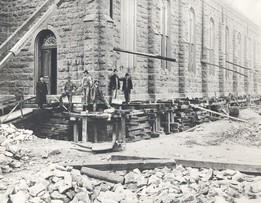 Click to enlarge.
Click to enlarge.
1909 saw the start of a major reconstruction project. The Passionists knew the church had a serious foundation problem that was affecting the upper structure of the building. The July 29, 1909 issue of the St. Paul Journal reported: "Work of raising St. Francis Church and putting a new foundation under it is starting." The Passionists had contracted with the Kansas City firm of Grant Renne to do what some people still consider unthinkable—the entire 7,000 ton structure was lifted from its foundation and a new basement foundation was installed. Moreover, most of the labor to lift the massive structure was done by area people under the supervision of Grant Renne engineers. When completed the church sat four feet higher making room for a basement chapel. There was no doubt that this needed to be done, but it also prepared the structure for the next major improvement.
The Passionist Monastery.
In 1911 the Passionists solidified their commitment in St. Paul when the Provincial Chapter decreed that a new retreat house would be built here. This was a major construction project requiring many changes to the existing church/school campus:
In 1911 the Passionists solidified their commitment in St. Paul when the Provincial Chapter decreed that a new retreat house would be built here. This was a major construction project requiring many changes to the existing church/school campus:
- The existing stone, three story monastery was razed (former Jesuit Monastery)
- The original Jesuit Infirmary/Guesthouse was lifted and moved to a location about six blocks west of the church. It remains there today as a bed and breakfast.
- The three-story College Hall structure was lifted and moved to a location east of the church where it served as a parish hall until 1960.
A True Community Presence.
In 1936 the new monastery became more than a retreat house. In August, St. Paul became the location of the new Passionist Novitiate of the West and those who lived here during the next three decades will always remember living in the monastic atmosphere. Classes of young men in heavy wool habits and sandals came and went annually. They seemed like very nice young men but we never really got to know them. They were required to remain silent much of the time. But, oh my—could they sing! Those who heard the monastery choir during Masses knew we had our own taste of Rome's Sistine Chapel Choir.
The beautiful novice garden (now our church garden) was built and completed in 1940. The garden tower that contains the bell from the original log church was also completed in the late 1940's. A couple of years ago we were honored with a visit from one of the novices who helped build the tower. Very sharp-of-mind in his 90's he recalled he and a couple of other novices, who showed mechanical aptitude, being rounded up and told they would be stonemasons. He also recalled the group might have needed special attention to stay out of mischief. In either case, they did a magnificent job.
We had priests—lots of priests. There were many scheduled Masses and some mornings there were Masses on all three of the front altars of the church. A few of us remember the center-side altars that were also used at times. Some people didn't know that there were also Masses in the upstairs chapels and the basement. Finding a Mass to fit farming or work schedules was not much of a problem. I recall mornings during Easter or Christmas when all three front altars were used for three back-to-back Masses.
On the celebration of Holy Days we had the benefit of participating in the multiple Masses, solemn processions, the music of the students and the deep religious experience that could only be appreciated with the monastery presence. Besides this, we had the privilege of attending several Passionist ordinations to the priesthood—a ceremony many people had to drive a long distance to witness.
More Transition.
The decades after the middle 60's were a tumultuous period with war, campus unrest and political problems. Given all of that, it seemed even worse here. After having been a Passionist novitiate for thirty years the St. Paul location was closed. The last novices left the St. Francis Retreat in 1966. More sad days followed.
On February 23 of 1983, the Passionists closed the St. Francis Monastery and Retreat house. After that, one Passionist remained as the Parish priest for a few years. When Father Luke Connolly left in 1987, and turned the parish and church property over to a diocesan priest, it ended more than 90 years of Passionist presence in St. Paul. After a few years of trying to re-purpose the majestic retreat house it too disappeared.
Most of us didn’t understand what we had lost until it was gone.
In 1936 the new monastery became more than a retreat house. In August, St. Paul became the location of the new Passionist Novitiate of the West and those who lived here during the next three decades will always remember living in the monastic atmosphere. Classes of young men in heavy wool habits and sandals came and went annually. They seemed like very nice young men but we never really got to know them. They were required to remain silent much of the time. But, oh my—could they sing! Those who heard the monastery choir during Masses knew we had our own taste of Rome's Sistine Chapel Choir.
The beautiful novice garden (now our church garden) was built and completed in 1940. The garden tower that contains the bell from the original log church was also completed in the late 1940's. A couple of years ago we were honored with a visit from one of the novices who helped build the tower. Very sharp-of-mind in his 90's he recalled he and a couple of other novices, who showed mechanical aptitude, being rounded up and told they would be stonemasons. He also recalled the group might have needed special attention to stay out of mischief. In either case, they did a magnificent job.
We had priests—lots of priests. There were many scheduled Masses and some mornings there were Masses on all three of the front altars of the church. A few of us remember the center-side altars that were also used at times. Some people didn't know that there were also Masses in the upstairs chapels and the basement. Finding a Mass to fit farming or work schedules was not much of a problem. I recall mornings during Easter or Christmas when all three front altars were used for three back-to-back Masses.
On the celebration of Holy Days we had the benefit of participating in the multiple Masses, solemn processions, the music of the students and the deep religious experience that could only be appreciated with the monastery presence. Besides this, we had the privilege of attending several Passionist ordinations to the priesthood—a ceremony many people had to drive a long distance to witness.
More Transition.
The decades after the middle 60's were a tumultuous period with war, campus unrest and political problems. Given all of that, it seemed even worse here. After having been a Passionist novitiate for thirty years the St. Paul location was closed. The last novices left the St. Francis Retreat in 1966. More sad days followed.
On February 23 of 1983, the Passionists closed the St. Francis Monastery and Retreat house. After that, one Passionist remained as the Parish priest for a few years. When Father Luke Connolly left in 1987, and turned the parish and church property over to a diocesan priest, it ended more than 90 years of Passionist presence in St. Paul. After a few years of trying to re-purpose the majestic retreat house it too disappeared.
Most of us didn’t understand what we had lost until it was gone.
Where We Are Today.
In 2009 we completed a new high school and gymnasium addition to our existing schools campus. That was the latest chapter in a story that began in April of 1847, with the opening of the Osage Manual Labor schools. St. Paul Schools and St. Francis de Heironymo Catholic Church had evolved over the years but they have always been on the same block of land.
In 2009 we completed a new high school and gymnasium addition to our existing schools campus. That was the latest chapter in a story that began in April of 1847, with the opening of the Osage Manual Labor schools. St. Paul Schools and St. Francis de Heironymo Catholic Church had evolved over the years but they have always been on the same block of land.
- Ours is the longest, continuous educational tradition in the state of Kansas. During the evolution from government Indian schools, through public schools and even the Jesuit - Loretto boarding schools; our educational institutions have never missed a term — Never!
- St. Francis de Heironymo Catholic Parish has had three homes: 1) Within one of the Mission school buildings for a few months; 2) In the log church from 1848 until 1884; 3) In our present, "new" church since May of 1884. St. Francis is also one of the oldest, continuous running parishes in Kansas.
|
Broaden Your Knowledge? The story above was summarized from www.acatholicmission.org. If you are interested in pursuing the story further, click on the illustration at the right to open the OUR STORY part of that website*. OUR STORY presents the Osage Mission/St. Paul story in sixteen chapters. Each chapter is illustrated and about the length of a magazine article. Chapters 1-4 set the stage for the arrival of the Jesuits and Lorettos at the mission. 5 -16 cover the period from 1847 through the 1980's. It even includes a chapter on law enforcement not included in the summary above.
You don't have to read it all at once. Take a few evenings to learn about the story of our hometown and Kansas in general. * The illustration might appear below on a phone. |
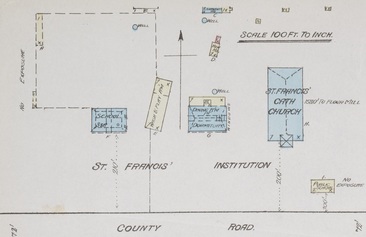 Cutout from 1885 fire insurance map showing showing positions of the two churches.
Cutout from 1885 fire insurance map showing showing positions of the two churches.
Some Reference Information:
Notes from above:
[1] The "Old Log Church" sat about 215 feet west of the existing church. The south end was a little north of the south face of the stone church; and it was situated at a 12 degree angle. Descriptions vary but it is known to have been built in three phases with the original structure built in 1848 with dimensions of 30' x 30' (but some accounts say 35'). There were two subsequent 30' additions that are visible in the photo at the top of the page. The final addition was of frame construction, instead of log, and the entire building was covered with weatherboard. After dedication of the new church in 1884 it was re-purposed into a wash and recreation building until it was razed in 1888.
The symbolism of the old church, and the mission that surrounded it, has carried several captions over the years. The more popular names are "The Cradle of Catholicism" and "Beacon on the Plains." Our current church has borrowed the "Beacon" nickname; but the term "Beacon on the Plains" was coined by Sister Mary Paul Fitzgerald in her book of the same name—she wrote about the mission — [2], below.
[2] Sister Fitzgerald's Beacon on the Plains focuses mostly on the Jesuits missionary work in Kansas ("... numerous outposts flung across southern Kansas"). Her book lists about 110 missions, all in Kansas. But there is passing discussion of other work in Colorado and Oklahoma. Ongoing research by the writer has increased this number to about 150 stations in Kansas, Oklahoma, Missouri, Arkansas and Colorado. These do not count three missions worked by Father Ponziglione during an assignment in Wyoming after he left Osage Mission. There are almost certainly more that will turn up with further research.
[3] William Whites Graves was a local newspaper man, historian and author. He was very active with the Kansas Historical Society and helped organize an early Neosho County Historical Society. He was also a founding member of the Kansas Catholic Historical Society, Atchison, Kansas. He wrote several books on the history of the Osage, the Catholic Mission and Neosho County. These included detailed biographical works about Father Schoenmakers, Sister Bridget Hayden and a general book about Father Ponziglione and other missionaries. In May of 1952, only weeks before his death, he was awarded a Vatican Knighthood of St. Gregory by Bishop Mark K. Carroll on behalf of Pope Pius XII. At the time of his death he was regarded as one of St. Paul and southeast Kansas’ most esteemed citizens. Follow THIS LINK for more about his life. There is also a display on the life and times of Mr. Graves in the Graves Memorial Public Library in St. Paul.
[4] Visit our LINKS PAGE for more information about our history. This includes links to some of regional churches and other sites that have ties to the Osage Mission Jesuit missionaries. And state and national websites that discuss the mission.
Additional Reference:
Notes from above:
[1] The "Old Log Church" sat about 215 feet west of the existing church. The south end was a little north of the south face of the stone church; and it was situated at a 12 degree angle. Descriptions vary but it is known to have been built in three phases with the original structure built in 1848 with dimensions of 30' x 30' (but some accounts say 35'). There were two subsequent 30' additions that are visible in the photo at the top of the page. The final addition was of frame construction, instead of log, and the entire building was covered with weatherboard. After dedication of the new church in 1884 it was re-purposed into a wash and recreation building until it was razed in 1888.
The symbolism of the old church, and the mission that surrounded it, has carried several captions over the years. The more popular names are "The Cradle of Catholicism" and "Beacon on the Plains." Our current church has borrowed the "Beacon" nickname; but the term "Beacon on the Plains" was coined by Sister Mary Paul Fitzgerald in her book of the same name—she wrote about the mission — [2], below.
[2] Sister Fitzgerald's Beacon on the Plains focuses mostly on the Jesuits missionary work in Kansas ("... numerous outposts flung across southern Kansas"). Her book lists about 110 missions, all in Kansas. But there is passing discussion of other work in Colorado and Oklahoma. Ongoing research by the writer has increased this number to about 150 stations in Kansas, Oklahoma, Missouri, Arkansas and Colorado. These do not count three missions worked by Father Ponziglione during an assignment in Wyoming after he left Osage Mission. There are almost certainly more that will turn up with further research.
[3] William Whites Graves was a local newspaper man, historian and author. He was very active with the Kansas Historical Society and helped organize an early Neosho County Historical Society. He was also a founding member of the Kansas Catholic Historical Society, Atchison, Kansas. He wrote several books on the history of the Osage, the Catholic Mission and Neosho County. These included detailed biographical works about Father Schoenmakers, Sister Bridget Hayden and a general book about Father Ponziglione and other missionaries. In May of 1952, only weeks before his death, he was awarded a Vatican Knighthood of St. Gregory by Bishop Mark K. Carroll on behalf of Pope Pius XII. At the time of his death he was regarded as one of St. Paul and southeast Kansas’ most esteemed citizens. Follow THIS LINK for more about his life. There is also a display on the life and times of Mr. Graves in the Graves Memorial Public Library in St. Paul.
[4] Visit our LINKS PAGE for more information about our history. This includes links to some of regional churches and other sites that have ties to the Osage Mission Jesuit missionaries. And state and national websites that discuss the mission.
Additional Reference:
- Information for this page was summarized from www.acatholicmission.org. Additional reference information regarding the above subjects is available from that website.
- The research room in the Osage Mission - Neosho County museum contains a large amount of information, including books, about the Catholic Mission and early Osage Mission/St. Paul History.
Home
|
This is the community website for the St. Francis de Hieronymo and St. Ambrose Catholic Churches in Neosho County, Kansas. Both churches are located in the center of the historic nine-county southeast Kansas area. We share one of the richest Catholic Heritages in Southern Kansas and the Four-State Region. For more information about our churches, history, organizations or programs browse our site including its links.
|
